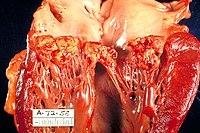
Photo from wikipedia
Abstract Many of the human infectious pathogens—especially the zoonotic or vector-borne bacteria—are fastidious organisms that are difficult to cultivate because of their strong adaption to the infected host culminating in… Click to show full abstract
Abstract Many of the human infectious pathogens—especially the zoonotic or vector-borne bacteria—are fastidious organisms that are difficult to cultivate because of their strong adaption to the infected host culminating in their near-complete physiological dependence on this environment. These bacterial species exhibit reduced multiplication rates once they are removed from their optimal ecological niche. This fact complicates the laboratory diagnosis of the disease and hinders the detection and further characterization of the underlying organisms, e.g. at the level of their resistance to antibiotics due to their slow growth. Here, we describe the current state of microbiological diagnostics for five genera of human pathogens with a fastidious laboratory lifestyle. For Anaplasma spp., Bartonella spp., Coxiella burnetii, Orientia spp. and Rickettsia spp., we will summarize the existing diagnostic protocols, the specific limitations for implementation of novel diagnostic approaches and the need for further optimization or expansion of the diagnostic armamentarium. We will reflect upon the diagnostic opportunities provided by new technologies including mass spectrometry and next-generation nucleic acid sequencing. Finally, we will review the (im)possibilities of rapidly developing new in vitro diagnostic tools for diseases of which the causative agents are fastidiously growing and therefore hard to detect.
Journal Title: FEMS Microbiology Reviews
Year Published: 2022
Link to full text (if available)
Share on Social Media: Sign Up to like & get
recommendations!